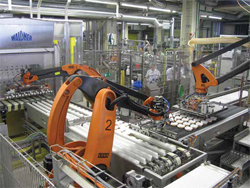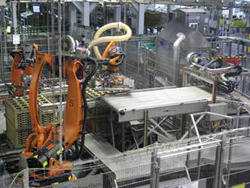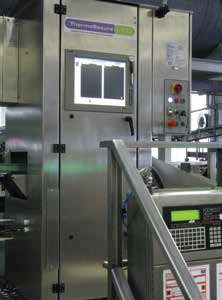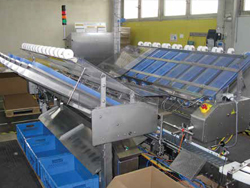A range of shelf-stable, microwavable, ready meals for babies and toddlers showed promise a few years ago. But packaging operations had to be optimized to make it viable.
 In the small German village of Werk Weiding about an hour’s drive from Munich is a perfect example of just what automation and machine vision inspection technology permit a food manufacturer to do.
In the small German village of Werk Weiding about an hour’s drive from Munich is a perfect example of just what automation and machine vision inspection technology permit a food manufacturer to do.
The food manufacturer in this case is Nestlé, the world’s largest. The product is NaturNes®, a line of shelf stable meals for children. Now on store shelves for about two years, NaturNes represents a relaunch of sorts. A nearly identical product was produced in a plant in France from 1998 to 2009. But it was withdrawn until Nestlé’s packaging engineers came up with a way to better automate the way it was packaged.
What it came down to is building a better mousetrap. And boy did they.
Let’s begin with a look at the NatureNes package. It holds about 250 g of product.
 MULTIPLE ROBOTS. Photo above shows how robots one, two, and three automatically move lidded plates to the retort crates. Photo left shows how robot five takes freshly retorted plates from pocketed trays and how robot six feeds just-emptied pocketed trays back into the closed-loop system.
MULTIPLE ROBOTS. Photo above shows how robots one, two, and three automatically move lidded plates to the retort crates. Photo left shows how robot five takes freshly retorted plates from pocketed trays and how robot six feeds just-emptied pocketed trays back into the closed-loop system.
depending on the variety—there are 20 or so, some for infants, some for toddlers—and it consists of four parts: plate, flexible lidding material, and a footed overcap with an in-mold label. Into the plate go three product components: cubed protein (chicken was in production on the day of our visit), vegetable mix (corn, carrots, peas, rice during our visit), and a sauce.
Once plates are filled and lidded, a quartet of robots places them into metal trays that fit into metal retort crates holding 425 plates each. The retort crates move automatically onto a shuttle that moves auto- matically to a large bank of retorts. An hour or so later, the shuttle removes the retort baskets from the cooking vessels and feeds them to secondary packaging, which is anchored by two more robots, 100% vision inspection, overcap application, and case packing on a pair of wraparound case packers.
And how many operators are required to make all this happen at an average of 180 plates/ min? Just eight. A better mousetrap indeed.
VISION INSPECTION A KEY
Managing much of the equipment specification and installation at the plant was Max Balhuber, whose business card succinctly identifies his title and role at Nestlé in a single word: Packaging. He points to the vision inspection system, which comes from Luceo , as one of the highlights of the sophisticated line. Luceo’s ThermoSecure L100 system exam- ines the sealing area of 100% of the plates, and if any product contamination is detected, that plate is rejected.
 “At this stage we see Luceo as the only appropriate partner for this kind of inspection,” says Balhuber. He notes that there are other suppliers offering such systems, but one thing that sets Luceo apart is the vision inspection reputation
“At this stage we see Luceo as the only appropriate partner for this kind of inspection,” says Balhuber. He notes that there are other suppliers offering such systems, but one thing that sets Luceo apart is the vision inspection reputation
that its parent company, Tiama, has in the manu- facturing of automobile glass.
According to Luceo’s Carole Besnard, Luceo makes all of its own vision inspection compo- nents and excels at all three major elements. First, the right camera and the right lighting are deployed in the image capture station. Second, the data captured by the camera is sent and processed by the best frame grabber at very high speeds. And third, the software processing the data is best in class.
In addition to determining if the seal of lidding material to tray flange is compromised, the Luceo system also singles out any pack that might have food product or sauce or other contamination on the white opaque top of the lidding. “Consumers are sensitive to such visual clues of quality, even though they have nothing to do with seal contamination or seal quality,” says Besnard.
“Consumers are sensitive to such visual clues of quality, even though they have nothing to do with
seal contamination or seal quality.”
One interesting bit of development work that had to be done jointly by Luceo and Nestlé revolved around the graphics on the flexible film lidding material. Originally the images were printed in a very dark blue. But the darkness of the ink made it difficult for the camera system to see through the blue ink for a good enough view of the plate flange to determine if there was product contamination on it or not. “So we lightened the print to a very light blue and it has resolved the problem,” says Balhuber. Another issue still being tweaked has to do with the small flap of material in the flexible film lidding that is designed to make it easier for the consumer to peel the package open. On rare occasions this piece of material gets bent back during the retort process, so that when it later undergoes inspection the camera system will see something out of the norm and consequently will cause that package to be rejected even though there is no product contamination and the hermetic seal is perfectly good. Adjustments in software algorithms have brought this situation nearly under control, and Balhuber says he expects it to be resolved soon.
IT STARTS UPSTAIRS
The first pieces of packaging equipment in the NatureNes line are on the floor above the filling and retorting equipment, where two custom-built systems from Del (www.delpackaging.com) feed the plastic plates and the in-mold-labeled overcaps down to the floor below.
“We needed the overcaps to be denested into a single lane, and Del was the only supplier that seemed able to come up with a solution,” says Balhuber.
Supplied by RPC Bebo , the white plates are thermoformed from a multilayer coextrusion of PP/white PP/EVOH/whitePP/PP. The intermittent-motion, volumetric pocket filler to which the upstairs Del denester delivers the plates is a Waldner Dosomat 20. Its transport belt takes plates eight across through three filling stations. In station one is a pocket filler for cubed meat or poultry. A floor-standing hopper of the cubed meat is placed right beside this station. A bucket elevator brings the meat cubes up to a screw that extends out and over the eight-across plates. The screw distributes product to eight pockets, and when these pockets are full, their bottoms open to dispense product into the plates below.
 UPSTAIRS DENESTER. Denesting of the plastic snap-on overcaps is done by this machine, which sits one floor above the filling/sealing equipment, the robots, the retorts, and the case packers.
UPSTAIRS DENESTER. Denesting of the plastic snap-on overcaps is done by this machine, which sits one floor above the filling/sealing equipment, the robots, the retorts, and the case packers.
A few feet later is station two, which operates in pretty much the same way except that it’s vegetables and rice that are being fed into the pocket filler and subsequently being deposited into the plates.
The final station on the Waldner system is where roll-fed lidding material is heat-sealed in place. Supplied by Mondi , the lidding is a multi-layer coextrusion of polyester/ tie/OPA/tie/white peelable PP. “The composition of that inner layer of white polypropylene is crucial,” says Balhuber, “because we need to ensure a hermetic seal in the retort yet we want the consumer to be able to easily open the container in the home.” Lidded plates in their eight-across orientation are picked from the Waldner transport belt by the vacuum cups of a Kuka robot. It takes 16 plates per cycle and turns 90 degrees to place the plates in two parallel conveyor lanes. A second Kuka robot uses its vacuum cup end effector to pick plates five across and two deep and put them onto an accumulation conveyor. From this accumulation conveyor, the vacuum pickup head of Kuka robot number three picks 25 plates at a time and puts them into the 25 pockets of a metal tray that sits in a metal retort crate. A fourth Kuka robot also plays a key role, though it does not touch the plates themselves. Its job is to continuously pick metal pocketed trays from a stack and place one on top of the metal pocketed tray that was just filled with plates. As soon as 17 filled metal pocketed trays are in a retort crate (425 plates per retort crate), that crate advances out of the robotic loading station and makes a 90-degree turn. Once four of these crates are in place, all four (totaling 1,700 plates) advance forward to a Kruse + Sohn shuttle that runs on a railroad track embedded in the floor. It transports the retort crates automatically to a row of retorts. The retorts and the shuttle system were already in place when the new plastic-plate-filling line was installed. These were used formerly for producing glass jars of baby food, a packaging format still in production elsewhere at the Werk Weiding plant. Balhuber and colleagues removed one glass line to put in the new plastic plate line and kept the shuttle system and retorts right where they were. A second shuttle was added to keep pace with the new plastic plate line.